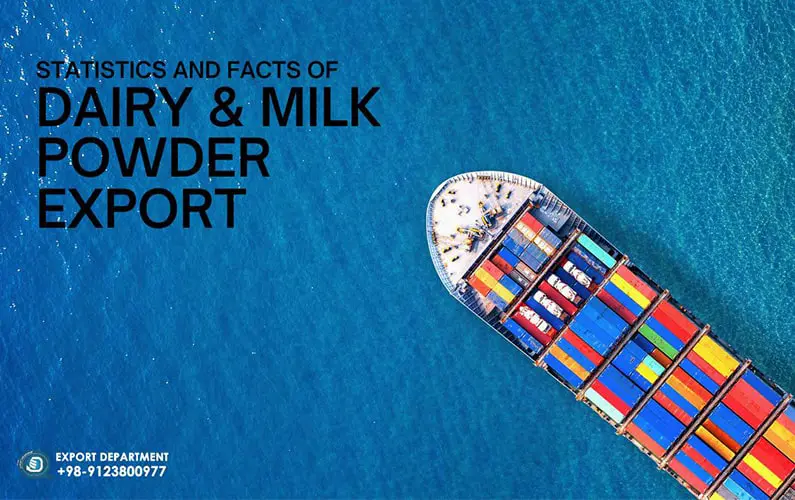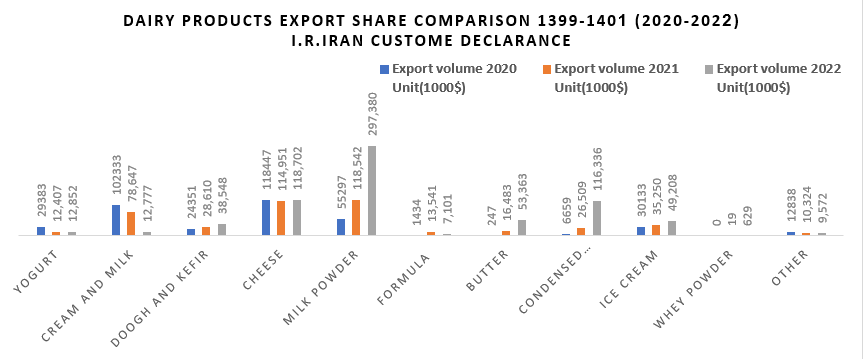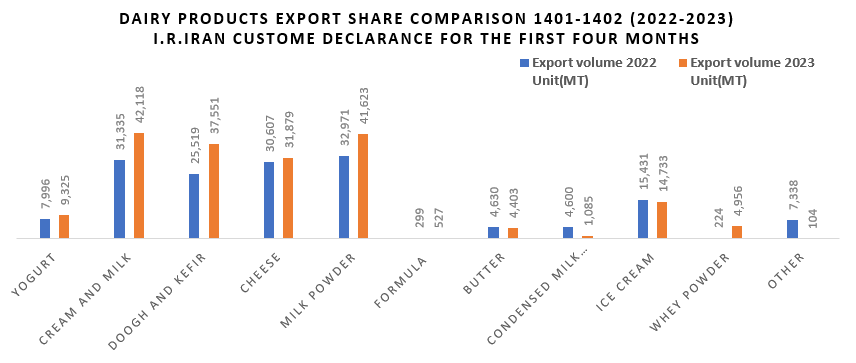
Understanding Iran's Dairy & Milk Powder Export Progress with Key Statistics and Facts
The Global Dairy Trade: Insights from Statistics and Facts
Dairy consumption traces its origins back over six thousand years, and in the present day, dairy products find their way into the diets of people worldwide. Over the course of the past two millennia, there has been remarkable creativity and innovation in the processing, fermentation, and consumption of dairy items. As of 2022, the worldwide dairy market held an estimated value of approximately 893 billion U.S. dollars, with projections indicating growth to reach 1,243 billion dollars by 2028.
One of the prominent outcomes of globalization is the widespread consumption of dairy products, with substantial volumes of milk, cheese, and other dairy items exchanged between nations every year. In 2022, the total value of dairy product exports amounted to just under 68 billion U.S. dollars, marking a significant rise from approximately 39 billion dollars in 2015.
The European Union, boasting nations like France, Ireland, and Germany renowned for their cheese and butter, dominates the global dairy product export market, commanding a 39 percent share—the largest among all world regions. Germany, as a notable contributor, independently exports about six billion dollars worth of cheese annually.
In 2022, the global dairy product export market reached an estimated value of around 68 billion U.S. dollars, a modest increase from the previous year's figure of approximately 66.56 billion dollars.
Notably, New Zealand emerged as the leading global milk exporter in 2022, with an export value of 7.8 billion U.S. dollars, followed closely by Germany, with milk exports amounting to 3.5 billion dollars during the same year.
Milk market outlook
In terms of production, the vast majority of dairy products are made with cow’s milk. India tops the list with the most number of milk cows of any country, at 59.5 million cows. The leading producer of cow milk in the world, however, is the European Union, followed by the United States, and then India. Although East Asian countries do not have a long history of milk consumption, in recent years China has increased its domestic milk production volume by nine million in the last ten years.
Exploring Industrial Milk Powder
Industrial milk powder, often referred to as powdered milk or dry milk, is a remarkable product obtained from liquid milk through a meticulous process of evaporation and drying.
Milk powder, a concentrated derivative of liquid milk, is predominantly prepared through the dehydration of liquefied milk via spray drying methods, resulting in its transformation into powder form. Its exceptional convenience, extended shelf life, and remarkable binding, foaming, and emulsifying properties render it indispensable as a food ingredient. Today, milk powder is consumed worldwide, owing to its rich composition of essential nutrients, including protein, vitamins, calcium, iron, sodium, cholesterol, potassium, fat, and carbohydrates, all of which play a pivotal role in promoting overall health and well-being.
The Stages of Production
The production of industrial milk powder encompasses several stages:
Collection and Pasteurization
Fresh milk is initially sourced from dairy farms and subjected to pasteurization. Pasteurization involves a controlled heat treatment that serves a dual purpose: it eliminates harmful bacteria while preserving the milk's essential nutritional properties.
Concentration
Following pasteurization, the milk undergoes a concentration process. This step involves the removal of a portion of its water content. Various methods, such as vacuum evaporation or reverse osmosis, are employed to achieve this concentration. Reducing the volume of milk is a pivotal step in preparing it for subsequent drying.
Drying
The concentrated milk is then subjected to drying techniques, with two primary methods prevailing: spray drying and roller drying.
1. Spray Drying
In spray drying, the concentrated milk is atomized and sprayed into a hot chamber. Here, the water content rapidly evaporates, leaving behind fine milk particles that are meticulously collected as a powder.
2. Roller Drying
Conversely, roller drying involves spreading the concentrated milk onto heated rollers. As the milk dries, it forms a thin layer that is subsequently scraped off, yielding powdered milk.
Cooling and Packaging
Following the drying process, the milk powder is gently cooled to room temperature. It is then meticulously packaged into an array of sizes and forms, ranging from bulk bags to consumer-sized containers.
Versatile Applications in the Food Industry
Among the positive effects of dry milk powder in the food industry, we can mention improving the taste and quality of products, increasing shelf life, providing nutrients, diversity, and ease of use. For this reason, powdered milk is used as an important ingredient in the food industry.
Longer Shelf Life
The removal of moisture during the production process significantly extends the shelf life of milk powder when compared to liquid milk. This prolongs its usability and minimizes the risk of spoilage.
Convenience
Milk powder's compact and lightweight nature makes it exceedingly convenient for transportation and storage. It doesn't require refrigeration and can be easily reconstituted with water.
Key Ingredients in Food Production
Milk powder serves as a fundamental ingredient in an array of food products, including baked goods, confectionery, beverages, and processed foods, enhancing their texture and flavor.
Nutritional Supplementation
In scenarios where access to fresh milk is limited, milk powder emerges as a valuable nutritional supplement, providing essential nutrients required for overall health development.
Variety of uses
Powdered milk can be used in the preparation of various food products. Including coffee, Nescafe, milk drinks, candy, sweets, pancakes, ice cream, dairy products, and baked goods.
Global Export and Distribution
One of its most compelling attributes is its global transportability. Countries with surplus milk production can effortlessly export their products to regions facing milk deficits, thereby contributing to global food security.
Export of milk powder in the world
Skimmed milk powder (SMP) is one of the most widely consumed dairy products in the world. China, New Zealand, the European Union, the USA, Australia, and Argentina are among the countries that have a significant presence in the export of non-fat dry milk. These countries have extensive dairy industries and export significant volumes of skimmed milk powder to meet global demand.
Export of milk powder in Iran
Historically, Iran has faced challenges in meeting the domestic demand for dairy products, including powdered milk. Factors such as population growth, urbanization, and changing food preferences have contributed to the increase in demand for dairy products. To fill the gap between supply and demand, Iran has relied on importing powdered milk from other countries. However, in recent years, Iran has taken measures to strengthen domestic dairy production and reduce dependence on imports. The government has implemented various policies to support and encourage the dairy industry, including improving infrastructure and investing in research and development. As a result of these efforts, Iran has made progress in increasing milk production and improving the quality of dairy products. This has led to a surplus of milk and changed the position of the country from an importer to an exporter of powdered milk. Iran's entry into the field of exporting milk powder indicates a positive development for the country's agricultural sector because it not only strengthens the country's self-sufficiency in dairy production but also opens up opportunities to generate income through exports. By exporting milk powder to other countries, Iran has benefited from its competitive advantage in the dairy industry and expanded its presence in international markets.
The former member of the Board of Directors of the Dairy Industry Association also says about the increase in the export share of dairy products: the reason for Iran's leadership in dairy exports is the decrease in the per capita consumption of milk and dairy products in Iran and the increase in the export share of these products. So the share of milk in export products has increased from 10% of milk produced in the country to 25%, which means an increase in exports.
(1).jpg)
In 1400 and 1401, Iran exported powdered milk products to several countries in the world. Countries importing milk powder from Iran include Syria, Lebanon, Nigeria (Africa region), Georgia, Armenia, Uzbekistan, Tajikistan, Kazakhstan, Azerbaijan, Turkmenistan (Eurasia region), Turkey (EU region), United Arab Emirates. Arabic, Kuwait, Oman, Qatar (GCC region), Pakistan, Iraq and Afghanistan. Accordingly, the highest amount of export in 1400 to Pakistan was equal to 40,250 tons, which increased by 24% to 53,000 tons in 1401, and the lowest export was to Nigeria in 1401.
Dairy Products Export Share comparison 1399-1401 (2020-2022) - I.R.Iran Custome Declarance

Dairy Products Export Share comparison 1401-1402 (2022-2023) - I.R.Iran Custome Declarance for the First Four Months
.png)
Dairy Products Export Share comparison 1399-1401 (2020-2022) - I.R.Iran Custome Declarance
.png)
Dairy Products Export Share comparison 1401-1402 (2022-2023) - I.R.Iran Custome Declarance for the First Four Months

Frequently Asked Questions (FAQ) :
Who are the key players in the Milk Powder Market?
Nestle SA, Gujarat Cooperative Milk Marketing Federation (Amul), Arla Foods amba, Fonterra Co-operative Group, and NOW Foods are the major companies operating in the Milk Powder Market.
Which is the fastest-growing region in the Milk Powder Market?
Asia Pacific is estimated to grow at the highest CAGR over the forecast period (2023-2027).
Which region has the biggest share in the Milk Powder Market?
In 2023, Europe accounts for the largest market share in the Milk Powder Market.
What are the largest markets for powdered milk in the world?
The countries with the highest volumes of consumption in 2022 were China, Brazil, and Algeria, with a combined 24% share of global consumption. Mexico, the United States, Indonesia, India, Italy, Germany, Vietnam, the Netherlands, the Philippines, and Belgium lagged somewhat behind, together comprising a further 31%.
What are the largest producers of powdered milk in the world?
The country with the largest volume of powdered milk production was New Zealand, accounting for 29% of the total volume. Moreover, powdered milk production in New Zealand exceeded the figures recorded by the second-largest producer, the United States, twofold. Brazil ranked third in terms of total production with a 6.2% share.
What is the average export price for powdered milk in Iran?
The average powdered milk export price stood at $2,340 per ton in 2022, reducing by -18.5% against the previous year.
What is the average import price for powdered milk in Iran?
The average powdered milk import price stood at $3,257 per ton in 2022, stabilizing from the previous year.
| [1] www.indexbox.io/store/iran-dried-milk-market-analysis-forecast-size-trends-and-insights |
| [2] www.statista.com |
| [3] www.linkedin.com/in/iran-dairy-industries-society |
